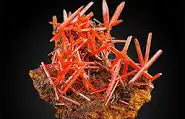
Crocoite: The Fire Within Stone — A Rare Specimen of Radiance and Raw Power
Among the vast spectrum of mineral kingdom wonders, few stones blaze with the boldness and rarity of Crocoite. With its electrifying red-orange hue and striking crystal formations, this mineral captures attention not only for its aesthetic brilliance but also for its energetic depth. It stands as a symbol of passion, vitality, and the flame of transformation — a natural fire forged in the earth’s shadows.

Geological Origins: Composition, Structure, and Provenance
Crocoite is a rare lead chromate mineral (PbCrO₄), formed through the secondary oxidation of lead ore deposits. Its fiery colour is due to its chromium content, which gives rise to its distinctive crimson to orange-red shades. Crystals are typically elongated and prismatic, often growing in clusters on a matrix of contrasting darker minerals, making them visually arresting in their raw state.
This mineral is exceptionally brittle and delicate, with a Mohs hardness of only 2.5 to 3. As such, it is seldom cut or faceted, and its value lies primarily in its natural, unaltered crystal formation — a trait highly prized by collectors and mineral specimen jewellery artisans alike.
The most renowned source of high-quality Crocoite is the Dundas region of Tasmania, Australia, where vivid, world-class specimens have been unearthed for decades. Other localities include Russia and South Africa, though these deposits tend to yield smaller or less intense crystals.
Metaphysical Meaning: Igniting Vitality and Transformation
Energetically, Crocoite is considered a stone of personal power, creative ignition, and spiritual awakening. It resonates primarily with the sacral and root chakras, stimulating the core of one’s emotional and physical vitality.
Crystal workers often turn to Crocoite for:
-
Stimulating creative flow and reigniting passion in art, love, or purpose
-
Assisting in major transformational life phases, acting as a catalyst for change
-
Clearing energy stagnation, particularly around sexuality or suppressed desire
-
Enhancing spiritual practices related to kundalini energy and energetic awakening
Because of its intense frequency and high vibration, Crocoite is often used in short meditative sessions rather than long-term wear. However, in its raw form — especially in mineral specimen necklaces or pendants — it becomes a powerful tool for those navigating high-energy spiritual journeys.
A Collector’s Delight: Fragile Beauty and Rarity
Crocoite’s appeal to collectors lies not just in its vivid hue but in its extreme rarity and delicate form. Because it is so fragile, specimens are often preserved in their natural state, protected under glass or mounted in protective mineral specimen jewellery. This fragility makes every intact crystal a treasure — particularly when it emerges fully formed and fiery from its matrix.
Unlike more durable stones used in mass-market jewellery, Crocoite retains its raw authenticity. This makes it highly sought-after by connoisseurs who value the stone’s unfiltered essence over its commercial polish. Each piece is a snapshot of Earth’s alchemy, forged over millennia and now poised as both adornment and artefact.
In the world of raw crystal jewellery, few stones make as bold a statement — or require as much care — as Crocoite. Its mere presence signals rarity, intention, and a deep respect for geological beauty in its most natural form.
Comparisons with Similar Minerals
Though often confused with Vanadinite or Realgar due to similar red-orange hues, Crocoite stands apart:
-
Vanadinite is more stable and often forms hexagonal clusters, while Crocoite’s prismatic, needle-like crystals are more ethereal in appearance.
-
Realgar, while also bright orange-red, is arsenic-based and generally avoided in wearable formats due to toxicity.
-
In energetic terms, Crocoite’s fire is more transformational than protective, and it lacks the grounding density of minerals like Garnet or Hematite.

Cultural Significance and Historical Lore
Unlike crystals with ancient mythological tales, Crocoite is a more modern mineral discovery, first identified in the 18th century. Its early name, Red Lead Ore, belied the majestic colouration that made it instantly desirable to collectors and mineralogists.
Despite its lack of ancient lore, Crocoite’s symbolism as an agent of awakening and passion resonates powerfully in contemporary crystal healing circles. It is often used in rituals focused on rebirth, shadow work, and overcoming fear — fitting for a stone that looks like solid fire.
In Jewellery: A Bold and Elemental Accent
Due to its fragility, Crocoite is rarely cut or set in traditional mounts. Instead, mineral specimen necklaces, wire-wrapped pendants, and display rings that allow for low-impact wear are preferred. When styled minimally, these pieces become statement artefacts, drawing both attention and energetic focus.
For those who are energetically sensitive or wish to incorporate high-frequency stones into their daily lives, wearing Crocoite in raw form offers a visceral connection to elemental fire and personal power. The unpolished structure allows the stone’s vibration to remain fully intact, enhancing its metaphysical effectiveness.
At Oryssia, we cherish stones like Crocoite not just for their aesthetic value, but for the stories and energies they carry — always raw, always real, always resonant.